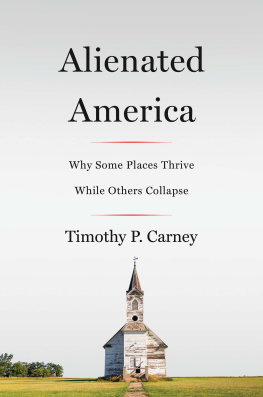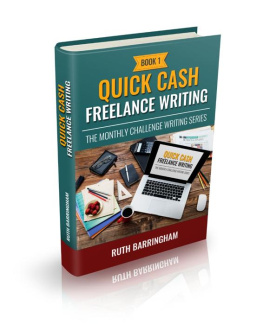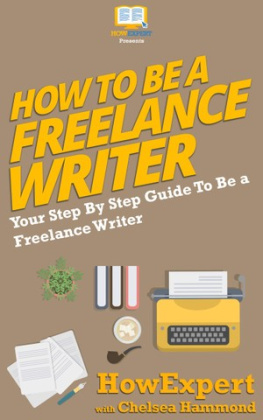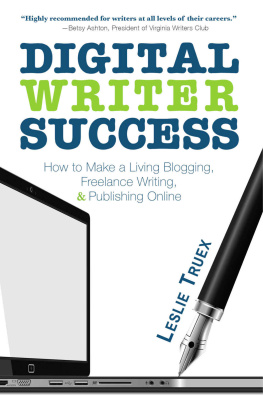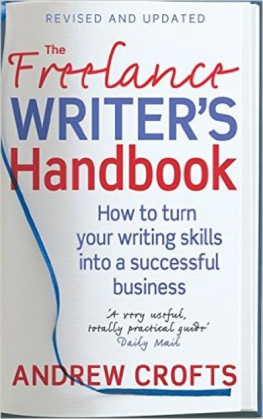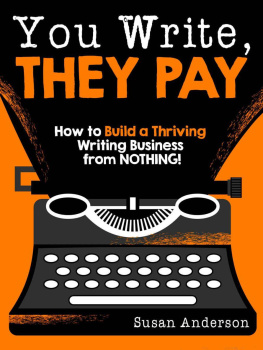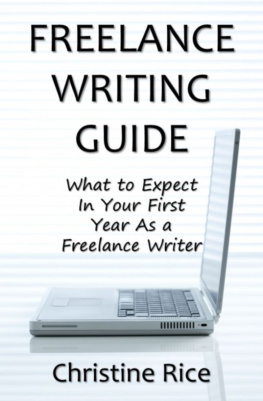The Quick and Dirty Guide to Freelance Writing
By Scott Carney
Contents
CHAPTER ONE
Introduction
This book is meant to inspire you to write for a living. The path to a sustainable writing career isnt always straightforward, but there are a few concrete steps that you can take that will give you a leg up on success. As we proceed, you might discover that Im not so much boosting your confidence as I am warning you about the potential pitfalls you will face. For some reason, when people get started on this path, they come with their accumulated baggage of what they think writing should be, not what it actually is. These notions lead to common mistakes where your client and audience have a different idea of what you are doing than you do.
That said, some of these early notions are useful to unpack. So before we get to the hard part, I first want you to have a clear vision of the kind of writer you want to be. When you started thinking about writing for a living, what did you see yourself doing? Are you a feature writer, covering deeply personal human interest stories? Are you an intrepid foreign correspondent, dodging in and out of war zones? Are you a food critic, eating at the finest restaurants in Manhattan? Will you pen scathing political commentary? Do you want to dish out the latest health trends? Are you writing cover stories for Sports Illustrated? Theres a niche out there for just about every writer, but very few people can do it all. Before you start, its important to know where, ideally, you want to end up.
This is because its not enough to simply write. The very first assignments that you take will begin to shape you. If youre not careful, they can become a sort of self-fulfilling prophecy. If you find that your first assignment is to write a regular column for a food blog but you really want to do political commentary, you might discover that it is a lot harder to change your business model and personal brand than if you had started writing what you had wanted to in the first place. This isnt to say that you wont occasionally write something outside of your genre; rather, as you create a body of work, that work is both what people come to expect from you and, more importantly, what you expect from yourself.
Of course its ok if youve already started writing and are just picking up this book to hone your skills. Its always possible to alter your course. It just gets more difficult. I didnt realize what sort of writer I wanted to become until I had already written a few stories for the smaller markets; however once I figured out that I wanted to write long, meaty features for big-budget publications and then go on to write books, my aspirations became a sort of roadmap that I used to direct my actions in the moment. Every job that I took after that realization was meant to improve my career. I learned to say no and I never took an assignment that I didnt think I would be proud of when it was done, or that wouldnt add to the portfolio I wanted to cultivate.
I think that its also important to mention that many writers who I would consider successful have taken very different paths to the one that Im laying out here. Theyve established different sorts of editorial relationships and achieved a certain amount of stability by taking whatever gigs they can get and growing slowly. Theres nothing wrong with a traditional route, exactly, but it is far from the most efficient way to make a living. Even established writers with clips in big-budget magazines can still learn a thing or two from reading this book that will help them grow their career further.
Theres a saying that seems appropriate to mention at this point: Dress for the job you want, not the one you have. I take this to mean you need to aspire to be something, rather than simply hoping that the path you are on at the moment will lead to your hearts desire. You are in command of your own career and if you want to be the top fashionista at a place like Vogue or Marie Claire , then you had better start making a plan to get there. Very few people outside of the worlds elite were born with pre-ordained success. Most of us are nobodies to begin with and the trick to achieving success isnt so much luck, as it is believing that our dreams are possible.
So, sit back and think a little bit about who you want to be. Think about in which publication you would most like to see your byline. Think about having a book made into film, attending a White House press briefing, pontificating about your most recent story on the radio or going on a world lecture tour. Enjoy that vision. Aspire to it. Realize that if you aim toward them, you have a chance of achieving your dreams.
CHAPTER TWO
How It Started
The grant rejections didnt come all at once, but they came with the steady, unrelenting pace of a funeral dirge. I was an anthropologist, or at least an aspiring one, and every letter in my mailbox was a signal that my academic career was about to end. For me, graduate school was an answer to the existential crisis of what a person was supposed to do with their life after bumbling their way through college. The original plan was straightforward. I hoped to become a professor, assume a tenure-track position and live a life of respect and prestige from within the confines of an ivory tower. Part of me wanted write the sorts of books that sparked new ideas and vigorous discussions and enliven classrooms. But more than that, I wanted a life of adventure where I could travel across the world, learn obscure languages and have a stash of ribald stories to pull out at cocktail parties.
Of course, before the glory, I had to pay my dues. So I got into a prestigious PhD program in Madison, Wisconsin and spent three years grinding through the coursework. Now I was at the point where I need to start researching my dissertation. What sets anthropological research apart from other sorts of academic inquiry is that it requires spending a long time in a foreign country and, in my case, that meant at least a year in India, working in Bombay. I was ready. And the only roadblock left was raising the $20,000 I needed to begin my adventures. I needed to land a grant.
Every year there are about 12 programs that accept applications to fund anthropological research. Some bear imposingly official names like the Social Science Research Counsel and Fulbright-Hayes. Others are more obscure, discipline-specific programs like Wenner-Gren and the American Institute of Indian Studies, which offer money in the small niche of research that I was trying to carve out for myself. Finally, there were the long-shots like the National Science Foundation, which could bankroll my entire career but are so incredibly unlikely that few anthropologists ever actually get them.
Without getting money from one of these programs, there would be no research, no PhD and no tenure track job waiting for me at the end of the seven-to-ten-year long process - which also meant no fun cocktail party stories to entertain my future friends. Whats more, every grant received hundreds of applicants for only a handful of spots and I desperately needed to outcompete my peers. If I failed, Id have to tread water in my program, probably taking a low-paying teaching assistant job to get by, as I repeated the application process next year. In the bowels of the social sciences building in Madison there were a few aging teaching assistants in a special type of academic limbo, who had unsuccessfully applied for research grants for ten years straight. Every year, they were just a little bit more in debt from tuition and student fees, squandering what could have been the formative years of their career if theyd just pursued a job in the outside world.
When the mailman dropped his bundle of mail through the slot in my door on a sweltering day in June 2005, I tried not to run to pick it up. Id already gotten 11 rejections; some of them included nice notes about how I might change future proposals. Others were less encouraging. And now came longest long shot of all: the National Science Foundation. I knelt down at the base of the mail drop and searched for the letter with the red and gray NSF logo in the upper left hand corner. My hands trembled a little bit when I picked it up and slid a pocket knife along the crease at the top of the all-too-thin envelope. I barely had to unfold the page before I saw the words We regret to inform you and I knew that I was destined to join the ranks of graying teaching assistants.
Next page

